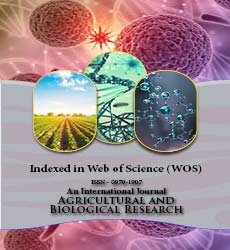Agricultural and Biological Research
RNI # 24/103/2012-R1
Adama Bagayogo*, Honore Kam, Jacques Sawadogo, Moumouni Konate, Satoshi Nakamura, Fujio Nagumo and Mahamadou Sawadogo
Iron toxicity and rice blast have been observed in the major tropical lowland and irrigated schemes. The objective of this study was to select new resistant/tolerant genotypes of rice to increase the varietal range. A trial was conducted in two (02) areas. An area without iron toxicity (Stox) and an area with iron toxicity (Tox). The plant material comprised of 64 genotypes of rice. The 64 genotypes were tested with several types of phosphate fertilizers in a split-splot experimental design with three (03) replications. The results showed that the triple super phosphate and the calcined phosphate were the best phosphate fertilizers in the management of iron toxicity and rice blasts. Rock phosphate is average efficient in the management of these two (02) physiological stresses. The genotypes (HB 46, HB62, KBR 2, KBR4, KBR 6, KBR 8, accession 68 and FKR 76) had the best yield compared to the controls Orylux 6 (FKR 84), Azucena in the TSP treatment. The accession 15, accession 225, accession 262, accession 270, accession 68 had the best yield in the calcined rock phosphate treatments. In all treatments, genotypes accession 225, CC 109 A, FKR 76, HB 46 and HB 62 had better yield and lower iron toxicity and rice blast scores.
